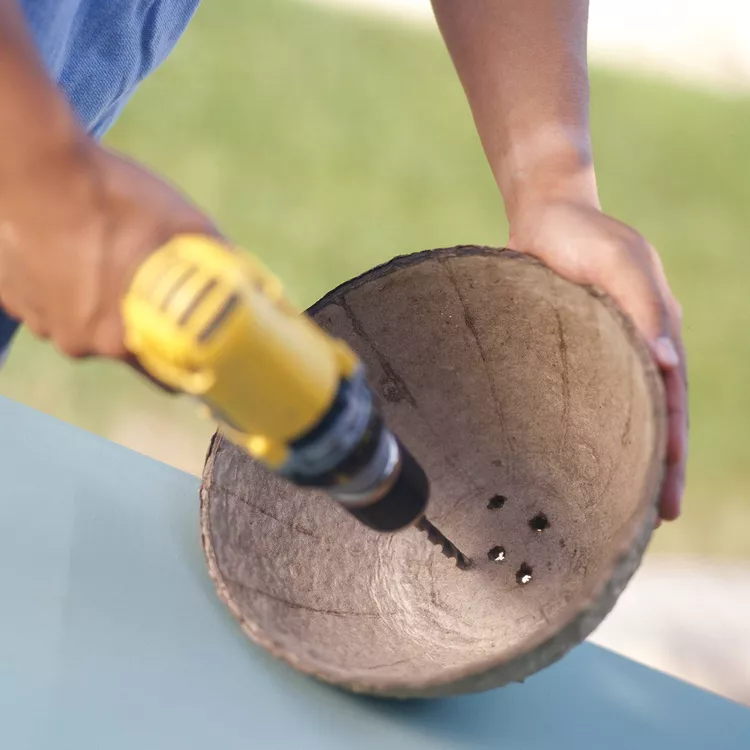Welcome spring—and all of your guests—with a simple hanging basket on your front porch. Hanging basket gardening is an easy way to add color to your yard without the commitment to (and space for) a larger garden plan. A coco fiber basket makes an attractive home for an assortment of plants, while a wire hanging basket with a coco liner gives an arrangement a more delicate look.
You can use different combinations of your favorite plants; just be sure they're suitable for the spot where you plan to hang your basket.
Follow our guide to how to make a hanging basket to enjoy. It takes less than 30 minutes!
Choosing a Basket and Liner
When choosing a hanging basket that complements your home, opt for a larger basket—it'll hold water better. Typical hanging baskets are made of wire, coco fiber, or plastic and come in diameters of 8 to 24 inches. Liners for wire baskets include sphagnum moss, coco fiber, burlap, plastic, and pressed paperboard.
Sphagnum moss and coco fiber are porous, so they'll dry out more quickly than pressed paperboard or plastic—however, softer materials make it easier to poke planting holes outside the basket. If you're using sphagnum moss for your basket, assemble it first. If you're using a paperboard liner, drill drainage holes in the bottom before planting.
You have two options for how to make a hanging basket part of your garden. Either install a hook on the ceiling or wall of a porch, patio, or deck or hang it from a freestanding shepherd's hook in the ground. You can place a hook in the ground wherever you feel height and color are needed. Keep in mind that a wet basket full of plants will be heavier than a dry basket, so your hook will need to be able to support the weight.
Soil for Hanging Baskets
Fill the basket with a lightweight potting mix. You can buy a packaged mix or make your own potting mix with equal parts peat moss, perlite, and vermiculite. Some prepackaged mixes contain slow-release fertilizer, allowing you to forgo semiweekly treatments with a quick-acting, water-soluble fertilizer. These help the soil hold nutrients during frequent watering.
The best way how to make a hanging basket grow and stay healthy is to add compost to the potting mix. Mix in water-absorbing crystals or line the container with a water-absorbing mat to maintain moisture. Fill the soil within an inch or two of the rim for ease in watering—if you overstuff it, water may drip out the sides.
Hanging Basket Flowers
Pick out various plants with different textures and colors for a bright and beautiful hanging basket. Baskets packed with a single kind of flower can also have loads of impact. For variety, use multiple species, including tall, midrange, and trailing forms. Place taller plants near the center and trailing plants along the edges to cover the sides.
Try to include varying bloom sizes. For example, vinca, miniature rose, and petunia offer large flowers, while hyssop, lobelia, and calibrachoa have dainty blooms. Plants with a mounding or spilling habit work well in baskets.
Think about whether your basket will hang in a sunny or shady spot, then select plants accordingly. You'll also want to consider if your plants will get along well—large, fast-growing plants may out-compete smaller ones.
Planting a Hanging Basket
Be careful not to overfill your basket. If it looks sparse now, don't worry; it'll fill in later. Generally, a 12"-14" basket can handle 3-6 plants, whereas a 16"-18" basket can hold around 5-7 plants. As you insert each plant into the basket, press down the soil around its base to secure it.
Watering Plants in Your Hanging Basket
Water the soil mix thoroughly after planting. After that, you may have to water daily in hot weather. Use a watering wand, so you don't have to take the basket down each time.
Lifting a basket is a quick way to judge if it needs water. The lighter the basket, the drier the soil. If the basket dries out during the season, the top of the soil may crust over. Break open the crust and wet the soil ball thoroughly.
Every so often, take down the basket and thoroughly soak it until water drains from the bottom. Pinch the tops of plants if they begin to look leggy, and rotate the basket weekly, so they all get equal sunlight.




















